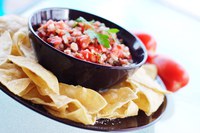Prairie Fare: Salsa, a saucy dance and a delicious sauce
(Click an image below to view a high-resolution image that can be downloaded)
One of the most popular Latin dances shares its name with one of the most popular condiments: salsa.
Learning how to do the fancy footwork of salsa dancing is good for your brain, heart and muscles.
Having some salsa also has potential health benefits. The low calorie level in salsa does not undo the calories you burned dancing or enjoying another physical activity.
You may want to think about how many chips you consume with the salsa, though.
Salsa, which is Spanish for “sauce,” usually is made from tomatoes, peppers and onions. Salsa is one of the most popular condiments in the U.S.
People spend more money annually on salsa than on ketchup. However, they probably buy more bottles of ketchup and add more ketchup to their foods. Ketchup typically is lower in cost compared with salsa.
Tomatoes are good for us. Tomatoes are rich in lycopene, a type of natural pigment from the carotenoid family. Lycopene is a good source of natural antioxidants, which may help protect us from heart disease and certain types of cancer.
Tomatoes also are rich in vitamin C, which helps our immune system stay strong and helps promote healing in wounds on our skin. The potassium in tomatoes and many other fruits and vegetables is good for our blood pressure and plays a role in the function of our muscles and nerves.
Enjoy more tomatoes and try your hand at making homemade salsa. The tomatoes and peppers are getting ripe for picking – or purchasing at farmers markets.
Salsa has different versions depending on the type of tomato or pepper used. Salsa’s spiciness depends on the type of pepper used to make it.
You can prepare “pico de gallo” (fresh salsa) with chopped tomatoes, onions, peppers, cilantro (if you like) and lime juice. It is not cooked.
You might see “salsa taqueria” (taco sauce) or “salsa roja” (literally “red sauce”) as options in Mexican restaurants. Salsa roja is a red salsa that is cooked and blended, while salsa taqueria is prepared similarly but tends to be spicier.
“Salsa verde” is a green sauce made by cooking tomatillos (husk tomatoes with light-brown paperlike husks) and other typical ingredients. It often is served chilled on burritos and other Mexican foods.
Salsa is a popular food that many beginning food preservers like to prepare and can at home. If you are making a fresh salsa that will not be canned, you can be as creative as you would like. If you want to preserve your creation, place it in the freezer in a freezer-safe container.
If you are making salsa that you intend to preserve in jars and store on your shelf, you need to be a scientist and follow a research-tested recipe. Some recipes on websites and shared on social media are not necessarily safe. Unsafe canning recipes can put you and your family at risk for the potentially deadly botulism.
Salsa is a mixture of acidic ingredients (lemon juice), low-acid ingredients (peppers, onions), and tomatoes, which are on the acidic side but can be borderline low-acid depending on the variety and growing conditions.
Tomatoes require the addition of an acidic ingredient, such as bottled lemon juice or citric acid, to make them safe for canning. Add 1 tablespoon of bottled lemon juice (or 1/4 teaspoon of citric acid) to pints of tomatoes and 2 tablespoons of bottled lemon juice (or 1/2 teaspoon of citric acid) to quarts of tomatoes before processing for the prescribed amount of time.
If someone gives you a gift of salsa they made, you might ask them some questions about how they made it.
- If you have a recipe you created, you can safely freeze the salsa.
- For canning recipes, follow the formulation exactly and measure/weigh ingredients carefully. Use bottled lemon or lime juice or vinegar as indicated.
- Choose the best produce for preservation. Overly ripe produce should be used in fresh recipes right away. Any type or color of tomatoes can be used to make salsa.
- Handle hot peppers carefully: Wear plastic gloves and wash your hands before touching your face.
- In canning recipes calling for spices, you may decrease the amount of spice (cumin, oregano, pepper, etc.) safely, but do not increase the spice amounts.
- To alter the “heat” in salsa, you can substitute one type of pepper for another safely, but keep the total amount of pepper the same.
- Do not thicken salsas with cornstarch before canning. If the salsa appears thin, it can be heated and thickened with cornstarch or some of the excess juice may be strained away after opening the jars.
- Follow the canning procedure closely in the tested recipes.
- Test seals the next day. A concave lid that does not move when pressed indicates you have a good seal. Remove the screw rings. Label sealed jars with the contents and canning date.
- Unsealed jars may be reprocessed safely within 24 hours, or the jars of salsa may be refrigerated for fresh consumption.
- See ag.ndsu.edu/food and navigate to “Food Preservation” then “Can” for safe (and flavorful) recipes for canning a wide range of foods, including several salsa recipes. The publication, “From Garden to Table: Salsa” includes a delicious recipe for fresh salsa and also recipes for canned salsa.
(Julie Garden-Robinson, Ph.D., R.D., L.R.D., is a North Dakota State University Extension food and nutrition specialist and professor in the Department of Health, Nutrition and Exercise Sciences.)
NDSU Agriculture Communication – Aug. 24, 2023
Source: Julie Garden-Robinson, 701-231-7187, julie.garden-robinson@ndsu.edu
Editor: Elizabeth Cronin, 701-231-7881, elizabeth.cronin@ndsu.edu




